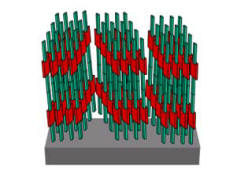
Handy Links
SLAC News Center
SLAC Today
- Subscribe
- Archives: Feb 2006-May 20, 2011
- Archives: May 23, 2011 and later
- Submit Feedback or Story Ideas
- About SLAC Today
SLAC News
Lab News
- Interactions
- Lightsources.org
- ILC NewsLine
- Int'l Science Grid This Week
- Fermilab Today
- Berkeley Lab News
- @brookhaven TODAY
- DOE Pulse
- CERN Courier
- DESY inForm
- US / LHC
SLAC Links
- Emergency
- Safety
- Policy Repository
- Site Entry Form

- Site Maps
- M & O Review
- Computing Status & Calendar
- SLAC Colloquium
- SLACspeak
- SLACspace
- SLAC Logo
- Café Menu
- Flea Market
- Web E-mail
- Marguerite Shuttle
- Discount Commuter Passes
-
Award Reporting Form
- SPIRES
- SciDoc
- Activity Groups
- Library
Stanford
Around the Bay
SSRL Aids Development of Plastic Electronics
 For close to a decade, researchers have been trying to improve the performance of plastic
semiconductors to the level of amorphous silicon—the semiconductor used in low-cost
electronics such as photovoltaic cells for solar power and thin-film transistors used in
flat screen laptops and TVs.
For close to a decade, researchers have been trying to improve the performance of plastic
semiconductors to the level of amorphous silicon—the semiconductor used in low-cost
electronics such as photovoltaic cells for solar power and thin-film transistors used in
flat screen laptops and TVs.
Stanford Synchrotron Radiation Laboratory (SSRL) and Stanford University researchers have now shown that the electrical performance of plastic semiconductors can be controlled and improved with surface treatments. In their research, published in the March issue of Nature Materials, they showed they could align the small crystals within the plastic polymer by applying a thin layer of organic molecules onto the surface. The highly-oriented crystals, visualized using x-ray scattering at SSRL, give the material better performance in conducting electricity.
In a related paper, published in the April issue of Nature Materials, Merck Chemicals in the United Kingdom developed a new polymer whose electrical mobility, related to conductivity, is the highest so far in a polymer. This endows the new polymer with performance comparable to amorphous silicon. SSRL, Stanford University and the Palo Alto Research Center characterized this new material, and found it has very highly-oriented crystals. "The structural properties of this new material are unprecedented for a polymer," said former Stanford graduate student Joe Kline, now a postdoctoral researcher at the National Institute of Standards and Technology.
Semiconducting polymers have many advantages over amorphous silicon: they are cheaper, faster and less energy-intensive to make; they can be dissolved in a solution and sprayed on, like ink from an inkjet printer; and they are flexible, an important trait for applications such as electronic paper.
—Heather Rock Woods SLAC Today, May 8, 2006
Image: A plastic polymer conducts electricity much better when small crystals within the plastic polymer are aligned perpendicular to the surface. (Image courtesy of Joe Kline, NIST.)